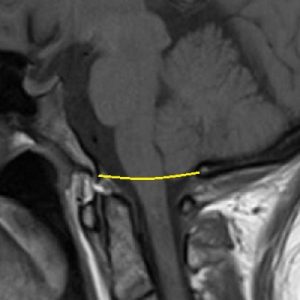A chronic and often progressive neurological condition in which a cyst (syrinx) fills with cerebrospinal fluid (CSF) inside the brainstem, often starting as a syrinx in the spinal cord (Syringomyelia) and extending upward into the medulla (bulbar area) of the lower brainstem (Syringobulbia). This cyst can enlarge and further compromising the brainstem. The extent of damage done by a syrinx in brainstem often depends on the size of the syrinx.
The exact reason syrinxes form is not quite clear, but they are believed to form from the blockage of CSF, just above the point of blockage (such as that consistent with a Chiari malformation, Spina Bifida, Tethered Cord Syndrome, a spinal cyst, a herniated disc, a spinal cord trauma/injury, or even meningitis can cause inflammation that can obstruct the flow of CSF).
Symptoms Include: Dizziness (vertigo; sometimes accompanied by nausea/vomiting); difficulty swallowing (dysphagia); problems breathing; snoring/sleep apnea; involuntary rapid movement of the eyeball (nystagmus); facial numbness/palsies/paralysis; small involuntary muscle contractions of the tongue (fibrillation); stuttering; hoarse voice (dysphonia); hearing loss; ringing in the ears (tinnitus); Dysautonomia

